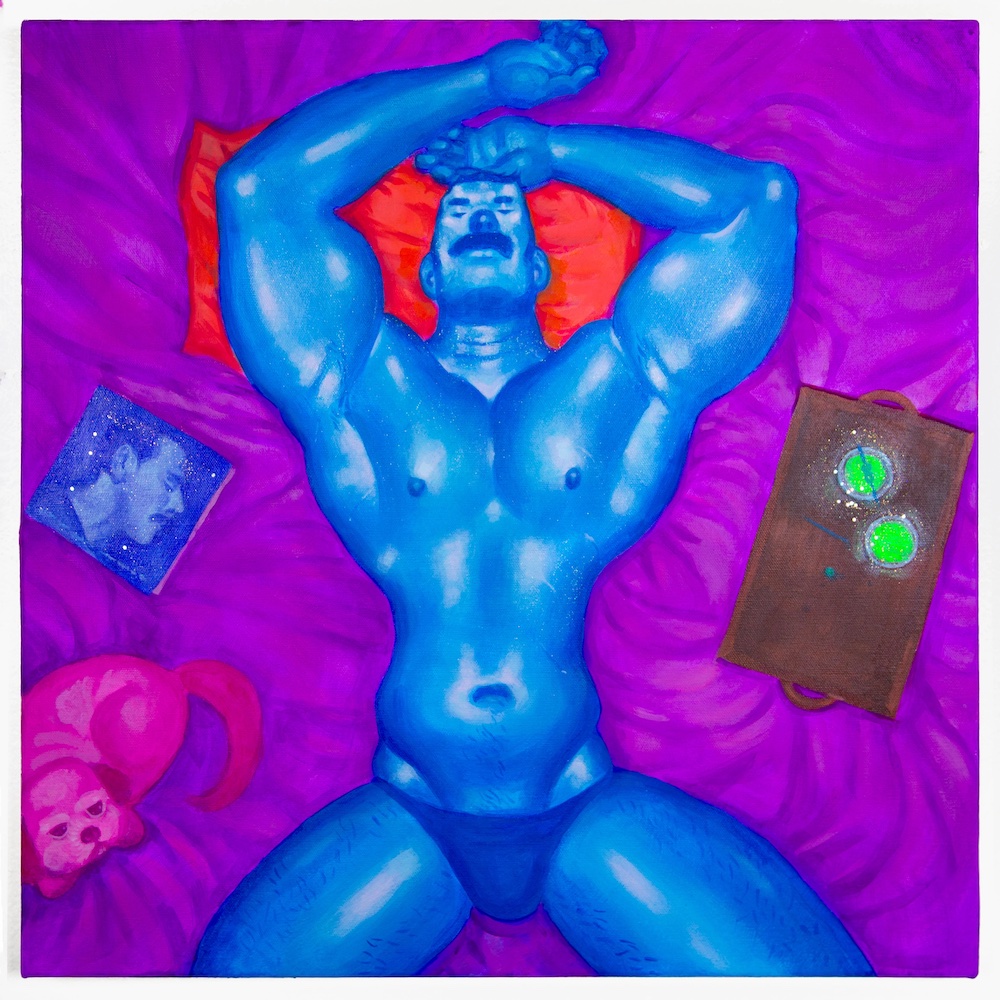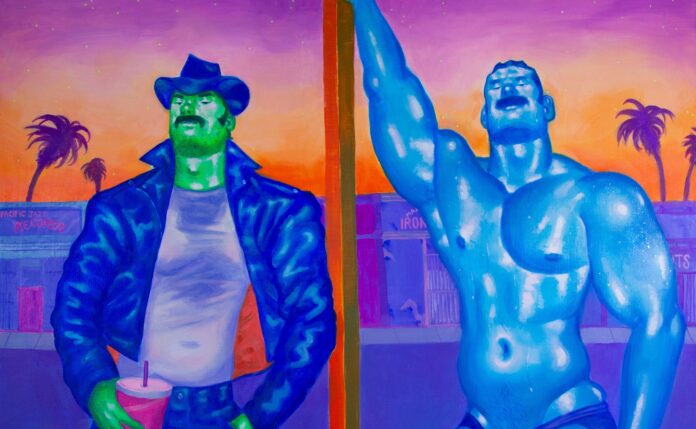Jonathan Carver Moore, who opened his eponymous Tenderloin gallery in the spring, contacted artist Justin Yoon last after Yoon’s solo show “Lunch at Sunset” at Anat Ebgi in Los Angeles. Moore was drawn to the square paintings with blues and purples and pinks, some with a faint trace of glitter—and he liked that Yoon’s art dealt with Asians and queerness, something Moore says you don’t see a lot in the art world.
Moore brought out the Brooklyn artist to San Francisco for his first show in San Francisco “Midnight Movie,” which runs through October 28 in Moore’s space.
In “Midnight Movie,” viewers get to know Yoon’s recurring characters: Marge the Space Queen, Blue Dream, Fivepoundz, and Machoman Park. The burly cast has its roots in Yoon’s childhood, when he and his brother drew comics, practicing their art by copying panels from manga.
At the gallery the day before the opening, Yoon talked with 48hills about feeling nostalgia for a time he didn’t even know, his father’s love of old films, of moving to Korea when he was six, and taking a graphic novel course at The New School/Parsons School of Design.
48HILLS How did your initial contact with Jonathan go?
JUSTIN YOON I loved his energy and what he had to say about art, and what he thinks of my work. I was open to anything, and then [“Midnight Movie”] eventually happened. It’s very exciting.

48HILLS Why did you start drawing characters?
JUSTIN YOON The reason why I came up with characters is because I was always interested in narrative work. I actually wanted to study film or screenwriting, but my talent was in painting. Always since I was a kid, I’ve been drawing and painting. I took a bunch of screenplay classes, at art school. I was also taking a graphic novel class—which was a writing class, basically a 10-page graphic novel class. I realized that this makes a lot of sense, this format of having repeating characters, because there’s a sense of kind of familiarity that everybody relates to. We grew up with TV shows or movies we watched over and over, and I wanted to capture that feeling. Not necessarily in a literal graphic novel format, but in what I loved to do, which is paintings. That process kept on going, I tried different characters over the years. Eventually, I came up with Blue Dream and Marge’s character kind of randomly. I was like, “I just really like the energy of these two, I’m going to keep on painting them.” Then I added the dog Fivepoundz, and this year I added the green guy, Machoman Park. I think as I grow older, and experience more and more, there might be more and more because there’s a lot more facets of myself or people around me that I need to portray. They are kind of representative—they’re all myself, or people I know, or all the feelings I’ve felt, or all the experiences I’ve had, personified in a certain way, a comical way.
Help us save local journalism!
Every tax-deductible donation helps us grow to cover the issues that mean the most to our community. Become a 48 Hills Hero and support the only daily progressive news source in the Bay Area.
48HILLS Your colors are so distinctive. How did you choose to work with them?
JUSTIN YOON I grew up loving sky blue, and the baby blue color mixed with pink. I always did. I loved the transgender colors even before it became the transgender flag. And I always used those pastel colors and then I started really loving neon colors, so I started incorporating them. And I liked the fact that they’re not necessarily a stereotypical color. I always kind of hated primaries, like I hated the strong blue and the strong red together. I used to not like green at all, but it kind of evolved more and more into me using those colors, like neon green, soft pink, or baby blues.
48HILLS Your work is often described as nostalgic or sort of dreamy. Is that what you’re going for?
JUSTIN YOON A little bit. Nostalgia is a big part of it. I think it’s very romantic feeling, even feeling a little bit of melancholy about oneself and the past. I always feel like it’s a little like going to a foreign country you can only visit once, and in your memory, it’s so clear your visit there. But then as the years goes by, it gets more and more idealized and more beautiful. You kind of change the whole image of it, but you can never go back to it, you know? That’s something I always want to capture. I think that’s what old movies or even novels do. That kind of feeling is what I want to create.
48HILLS And do you feel like it’s nostalgia for the movies or those times? Or is it nostalgia for childhood?
JUSTIN YOON I think it’s both. I grew up watching a lot of old movies. My dad was a big jazz fan and a movie fan. So, we grew up watching TV and old Hollywood movies on late night TV and Hollywood musicals, and that had a big impact on me. Everybody kind of experiences this kind of fake nostalgia that you feel toward a certain time that you were never even born in. I think those kinds of feelings started merging in with my own childhood almost. It started when I was really obsessed with Dazed and Confused in high school, and I was so obsessed with the ’70s, and “That ’70s Show,” and all that stuff. I wasn’t even born then, but in my head, it’s like, “I miss that kind of feeling.” It’s just like this weird mixture of my own past nostalgia blurring the lines with this fantasy of nostalgia. I think it’s very romantic thing that everybody feels.
48HILLS What old movies did your dad like to watch?
JUSTIN YOON Casablanca. Also, a lot of Billy Wilder movies, lots of Marilyn Monroe movies—that kind of stuff. Old musicals too, like Judy Garland and A Star is Born. My dad loved all the jazzy stuff. He wanted to be a musician, but he was an engineer. He was talented in music. He played guitar and banjo and stuff like that. He used to yodel also. He loved all the classics, like Kubrick and Hitchcock and all that stuff. He sat me down and made me watch 2001: A Space Odyssey when I was like nine or 10. And I was like, “What are you doing to me?” but now I appreciate it.

48HILLS How do you feel like Hollywood and those movies and growing up in LA influenced you?
JUSTIN YOON I left LA pretty young because when I was six, I moved to Korea with my family. But I was still brought up with all this American pop media culture even after I moved to Korea, because my dad was a big movie person. So, for me, it was not just a big impact of where I was born in LA, but also because I couldn’t go back to it. Even just watching sitcoms like “Friends,” and “Will and Grace.” Of course, they’re set in New York, but they’re so LA. When I watched them, the Hollywood artifice was so near and dear to me, and kind of formed my identity in a way.
48HILLS How did growing up in Korea affect your art?
JUSTIN YOON I think the kind of dreamy idea itself is impacted by me growing up in Korea. The whole Americana idea—like, I’m speculating here—but if I just grew up in the States, I don’t think the dreamy aspect would have been as strong because being in Korea. This might be kind of ironic, but I felt like I didn’t really belong culturally, almost. I dreamed of American culture always, you know, even playing The Sims games, which are like an idealized, funny version of an American sitcom. Playing those, and these characters and reading comic books and stuff like that, it definitely had a big impact on me. Korean culture was a big influence as well, for sure, without me even knowing it. I only realized that after I came back, and when I started having nostalgia for Korea.
48HILLS And what made you want to go to Parsons?
JUSTIN YOON I wanted to go to New York. I always wanted to. I visited once when I was in high school with my family, and I just loved the vibe. You know, me being gay also, I always wanted to go to a more gay-friendly city. I mean, I’m sure Korea is much more gay-friendly now, but back then, you didn’t see any gay people on TV, or any representation. So, for me, I felt like the only representations that I can really relate to came from America or the UK.
48HILLS What did you like about Parsons?
JUSTIN YOON Majoring in illustration there was a big influence. In our year, in illustration, there were several different groups we could go into where you do more editorial, more comics, or animation. There was also a fine art one, which was more painting-based, and my instructors were all fine art painters who had studied illustration in the past, so I followed in their steps.
JUSTIN YOON: MIDNIGHT MOVIE runs through October 28. Jonathan Carver Moore, SF. More info here.






